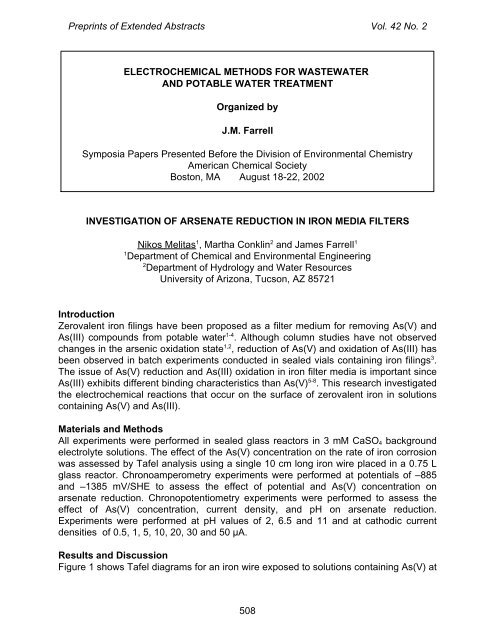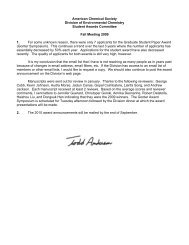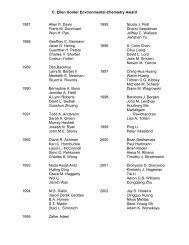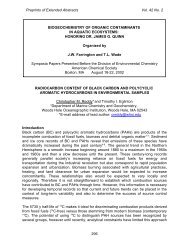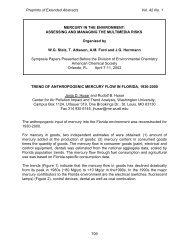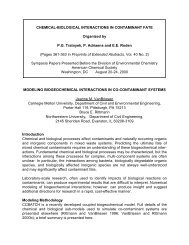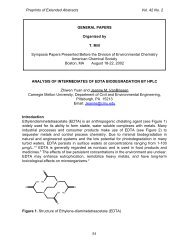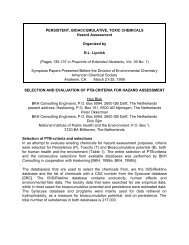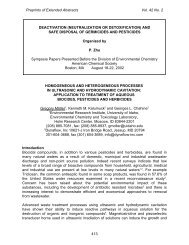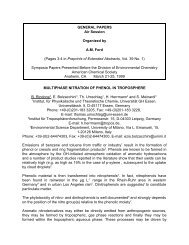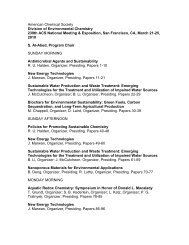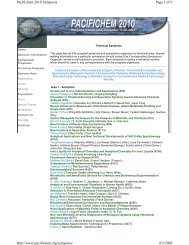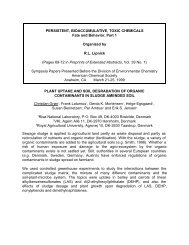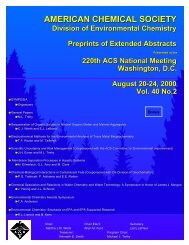paper 66 - ACS: Division of Environmental Chemistry
paper 66 - ACS: Division of Environmental Chemistry
paper 66 - ACS: Division of Environmental Chemistry
Create successful ePaper yourself
Turn your PDF publications into a flip-book with our unique Google optimized e-Paper software.
Preprints <strong>of</strong> Extended Abstracts Vol. 42 No. 2<br />
ELECTROCHEMICAL METHODS FOR WASTEWATER<br />
AND POTABLE WATER TREATMENT<br />
Organized by<br />
J.M. Farrell<br />
Symposia Papers Presented Before the <strong>Division</strong> <strong>of</strong> <strong>Environmental</strong> <strong>Chemistry</strong><br />
American Chemical Society<br />
Boston, MA August 18-22, 2002<br />
INVESTIGATION OF ARSENATE REDUCTION IN IRON MEDIA FILTERS<br />
Nikos Melitas 1 , Martha Conklin 2 and James Farrell 1<br />
1 Department <strong>of</strong> Chemical and <strong>Environmental</strong> Engineering<br />
2 Department <strong>of</strong> Hydrology and Water Resources<br />
University <strong>of</strong> Arizona, Tucson, AZ 85721<br />
Introduction<br />
Zerovalent iron filings have been proposed as a filter medium for removing As(V) and<br />
As(III) compounds from potable water 1-4 . Although column studies have not observed<br />
changes in the arsenic oxidation state 1,2 , reduction <strong>of</strong> As(V) and oxidation <strong>of</strong> As(III) has<br />
been observed in batch experiments conducted in sealed vials containing iron filings 3 .<br />
The issue <strong>of</strong> As(V) reduction and As(III) oxidation in iron filter media is important since<br />
As(III) exhibits different binding characteristics than As(V) 5-8 . This research investigated<br />
the electrochemical reactions that occur on the surface <strong>of</strong> zerovalent iron in solutions<br />
containing As(V) and As(III).<br />
Materials and Methods<br />
All experiments were performed in sealed glass reactors in 3 mM CaSO4 background<br />
electrolyte solutions. The effect <strong>of</strong> the As(V) concentration on the rate <strong>of</strong> iron corrosion<br />
was assessed by Tafel analysis using a single 10 cm long iron wire placed in a 0.75 L<br />
glass reactor. Chronoamperometry experiments were performed at potentials <strong>of</strong> –885<br />
and –1385 mV/SHE to assess the effect <strong>of</strong> potential and As(V) concentration on<br />
arsenate reduction. Chronopotentiometry experiments were performed to assess the<br />
effect <strong>of</strong> As(V) concentration, current density, and pH on arsenate reduction.<br />
Experiments were performed at pH values <strong>of</strong> 2, 6.5 and 11 and at cathodic current<br />
densities <strong>of</strong> 0.5, 1, 5, 10, 20, 30 and 50 µA.<br />
Results and Discussion<br />
Figure 1 shows Tafel diagrams for an iron wire exposed to solutions containing As(V) at<br />
508
Preprints <strong>of</strong> Extended Abstracts Vol. 42 No. 2<br />
concentrations ranging from 0 µg/L to 20,000 µg/L. The lower cathodic currents at each<br />
potential in the four arsenate solutions indicate a decrease in the exchange current for<br />
water reduction. The observed decrease in the exchange current for water reduction<br />
can be attributed to the blocking <strong>of</strong> cathodic sites by arsenic compounds chemisorbed<br />
to the iron surface. For potentials lower than -475 mV, the lower anodic currents in the<br />
As(V) solutions indicate that the anodic exchange current for iron oxidation was<br />
diminished in the presence <strong>of</strong> arsenic. The decrease in the anodic exchange current<br />
can be attributed to the blocking <strong>of</strong> anodic sites by adsorbed arsenic compounds. The<br />
change in the anodic slopes at a potential <strong>of</strong> approximately –475 mV may be attributed<br />
to oxidation <strong>of</strong> iron complexed with arsenic.<br />
Figure 2a shows chronoamperometry pr<strong>of</strong>iles for an iron wire cathode at an applied<br />
potential –885 mV. For solutions with final concentrations <strong>of</strong> 10 and 100 mg/L, As(V)<br />
was added to each solution at the indicated concentration at 5.5 minutes elapsed. In<br />
the solution with a final concentration <strong>of</strong> 1000 mg/L, the As(V) was added in three<br />
increments at 5.5, 5.8 and 6.1 minutes elapsed. Only when the solution concentration<br />
reached 1000 mg/L was a current pulse for arsenic reduction observed. This current<br />
pulse was for reduction <strong>of</strong> arsenate chemisorbed to the iron surface. Changes in<br />
solution concentrations <strong>of</strong> As(III) confirmed that there was no reduction <strong>of</strong> solution<br />
phase As(V) in any experiments conducted at neutral and alkaline pH values at a<br />
potential <strong>of</strong> –885 mV. However, at a pH value <strong>of</strong> 2, chronopotentiometry experiments<br />
showed that arsenate reduction occurred over a wide potential range.<br />
2.5<br />
1.5<br />
0.5<br />
-0.5<br />
-1.5<br />
0 µg/L<br />
β c = 0.007mV -1<br />
100 µg/L<br />
-750 -650 -550 -450 -350<br />
E (mV SHE)<br />
5000 µg/L<br />
β a = 0.016mV -1<br />
10000 µg/L<br />
20000 µg/L<br />
Figure 1. Tafel scans for an iron wire electrode in anaerobic solutions containing As(V)<br />
at the indicated concentration at a pH value <strong>of</strong> 6.5. The electrode was equilibrated with<br />
each solution for 1 day prior to performing each scan.<br />
509
Preprints <strong>of</strong> Extended Abstracts Vol. 42 No. 2<br />
250<br />
200<br />
150<br />
E=-885 mV<br />
100 mg/L<br />
5 6 7 8 9 10<br />
Elapsed Time (min)<br />
1,000 mg/L<br />
0 mg/L<br />
10 mg/L<br />
Figure 2. Chronoamperometry pr<strong>of</strong>iles for an iron wire electrode in anaerobic 3 mM<br />
CaSO4 electrolyte solutions at a potential <strong>of</strong> -885 mV and a pH value <strong>of</strong> 6.5.<br />
References<br />
1. Lackovic, J. A.; Nikolaidis, N. P.; Dobbs, G. M. Env. Eng. Sci. 2000, 17(1), 29.<br />
2. Farrell, J.; Wang, J. P.; O’Day. P.; Conklin, M. Environ. Sci. Technol. 2001, 35,<br />
2026.<br />
3. Su, C.; Puls, R. W. Environ. Sci. Technol. 2001, 35, 1487.<br />
4. Khan, A. H.; Rasul, S. B.; Munir, A. K. M.; Habibuddowla, M.; Alauddin, M.; Newaz,<br />
S. S.; Hussam, A. J. Environ. Sci. Health 2000, A 35(7), 1021.<br />
5. Pierce, M. L.; Moore, C. B. Water Res. 1982, 16, 1247.<br />
6. Raven, K. P.; Jain, A.; Loeppert, R. H. Environ. Sci. Technol. 1998, 32, 344.<br />
7. Manning, B. A.; Fendorf, S. E.; Goldberg, S. Environ. Sci. Technol. 1998, 32, 2383.<br />
8. Jain, A.; Raven, K. P. Loeppert, R. H. Environ. Sci, Technol. 1999, 33, 1179<br />
510


